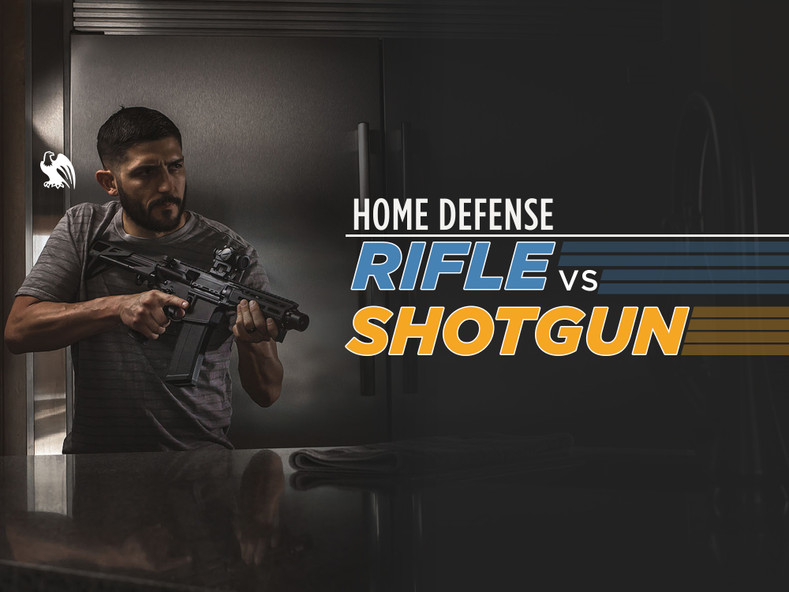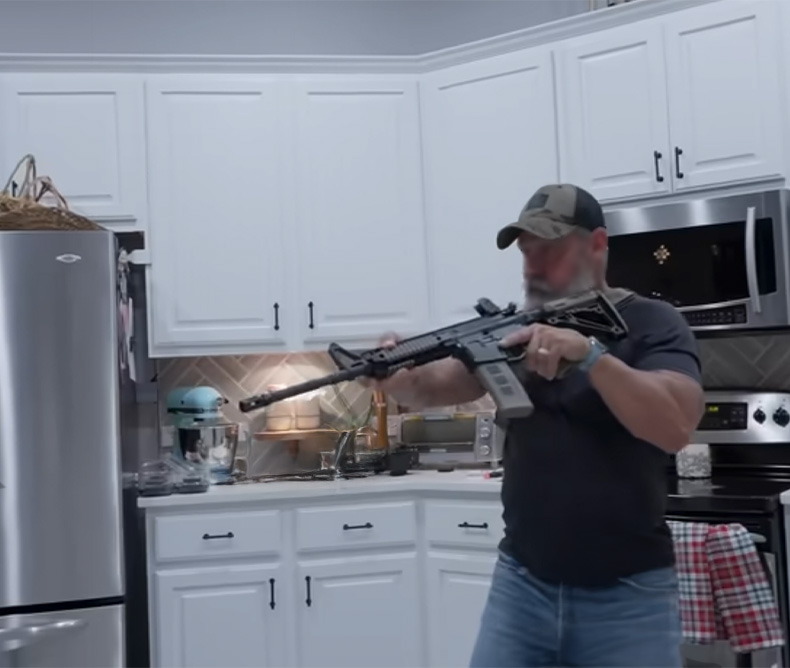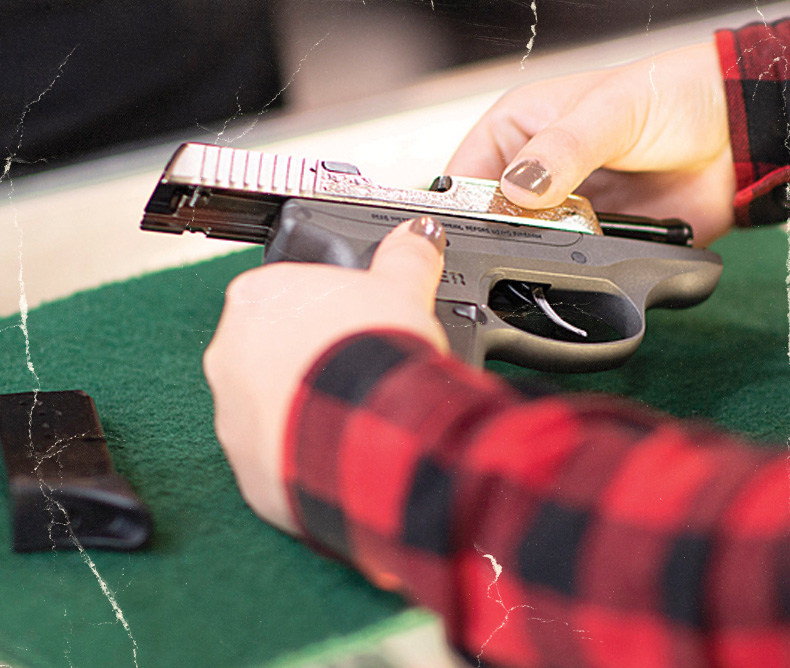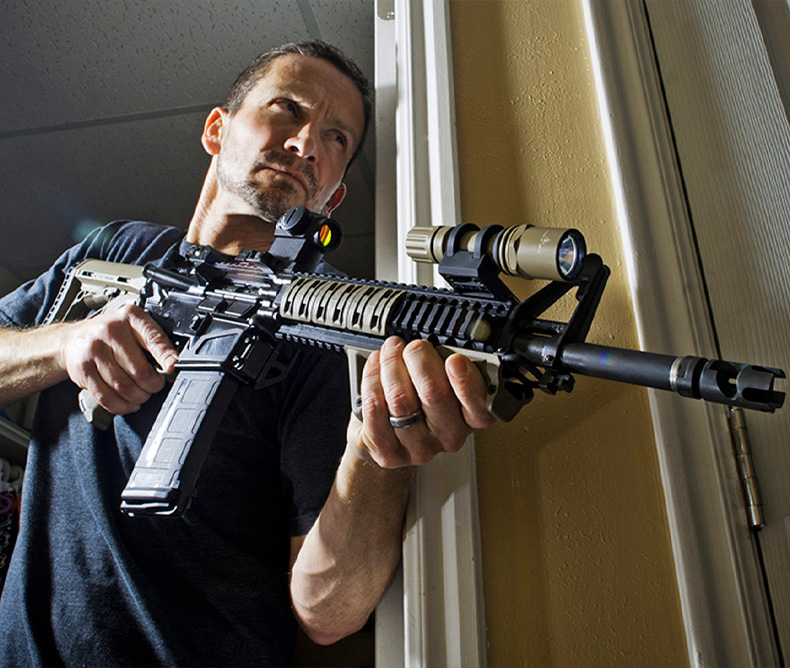Rifle vs Shotgun: Which is Better for Home Defense?

There are seemingly limitless variables that need to be considered when it comes to choosing a weapon for home defense. Your house’s layout, occupancy, and location are all factors that should be weighed when deciding what will work best for you.
Long guns are commonly used for home protection. But with all variables taken into account, is a rifle or shotgun better for home defense?
When comparing a rifle vs shotgun for home defense, it's clear they are extremely different in terms of function and operability. Rifles offer more capacity and adaptability, but shotguns produce outstanding damage, stopping intruders in their tracks. Although both are effective choices, the type of ammunition, amount of recoil, and maneuverability of each should strongly be considered based on your specific situation.
This article aims to highlight the benefits and drawbacks of each so that you can make the best decision when choosing a gun for home defense.
Home Defense Rifle Overview

The modern state of home defense rifles is about being able to meet the demands of each and every person on the market. No longer do we live in the days of manufacturers releasing rifles that only come in a single caliber or without adaptability. Size, color, and accessories are limitless today, and one of the best examples of this is the widely popular AR-15.
Though not limited to the AR-15, as can be seen in the Marlin 1895 Dark Series, for example, this adaptability is great to help ensure that every possible user can create a setup that best works for them – no matter what their needs. This is highly important when preparing for tense situations.
What this adaptability can’t mitigate, however, is the problems one will encounter when moving through close quarters with a long gun. Houses are made of numerous nooks, hallways, and rooms, which can be hard to navigate when you’re holding a 40-inch gun.
Home Defense Shotgun Overview

For the most part, shotguns haven’t needed to change all that much over the last few decades. They are a tried and true choice for homeowners all across America. A testament to this is the Remington 870, which is still one of the most popular self-defense shotguns in the country, despite being released in 1950.
What has changed is the common perception of a shotgun’s usage when it comes to home defense. No longer can you assume that “rack it and the bad guys will run away” is a safe line of thinking that reflects your modern criminal. After all, home invasions usually aren’t committed by reasonable people.
When you find yourself in such situations, you have to be prepared to use your gun to its fullest ability, and shotguns have the ability to produce catastrophic effects thanks to their high energy output.
Shotgun vs Rifle: Maneuverability

Though it is highly encouraged to barricade yourself in place during a home defense situation and wait for police, some circumstances, such as checking on children, may require you to navigate through your home. When taking an honest look, both rifles and shotguns face many of the same challenges in terms of maneuverability in comparison to a handgun.
The average barrel length of long guns is around 21 to 24 inches, with long guns for home defense measuring around 16 to 18 inches. Either way, this creates restraints in movement because the average hallway in America is only 36 to 42 inches wide. No matter what kind of long gun you use, you won’t be able to freely change direction in a hallway while remaining in the ready-up position.
That being said, the ready-up position doesn’t allow for all the reactions that may be necessary in tight situations anyway. According to an Iron Survival article on close quarters battle weapon carrying techniques, high carry is the best method to use in a physical contact situation and allows for striking movements as well as uncompromisable carry.
So, while rifles and shotguns face similar obstacles when it comes to maneuvering through a house, with proper techniques and adequate training either could be a viable option for home defense.
Rifle vs Shotgun: Functionality

In recent years, the home defense rifle market has increasingly embraced semi-automatic platforms, like the AR-15, for self-defense. These rifles offer high-capacity magazines, ease of handling, and quick follow-up shots, making them a go-to option for many. On the other hand, the shotgun market has largely remained focused on pump-action models thanks to their simplicity, durability, and affordability. That said, semi-automatic shotguns are also available and are a great option for home defense. Depending on what you choose to buy, this functionality needs to be taken into consideration when creating a strategy for protecting your home.
Semi-automatic rifles are probably the easiest to account for because of their high-capacity magazines and general reliability when put to work.
With a semi-auto rifle, keeping track of how many shots you’ve taken is less important; as soon as you’ve finished one magazine, it’s easy enough to pull the next out of your pocket and keep going (assuming you have a spare mag, which you may or may not depending on the situation). The probability of a jam or misfire is also relatively low, though it is still important to maintain your weapon and use high-quality ammo to help ensure that.
When it comes to shotguns, one major hurdle to account for is capacity. Most shotguns can only hold anywhere from 2 to 10 rounds, depending on the model. This can potentially leave a home defender in a tough situation when it comes time to reload, especially if you’re working with a lower-capacity gun.
This is why a shoot, pump, scan, load motion for pump actions and a shoot, scan, load motion for semi-automatics, is recommended for home defense, firearms trainer Mike Seeklander writes in a Personal Defense Network article. Because this allows for the quickest and most secure shotgun reload possible, this technique should become a regular part of your home defense training.
A middle ground between semi-automatic rifles and shotguns that is worth noting is lever action rifles. In the hands of an experienced shooter, they can be a highly efficient self-defense weapon, but they do come at the disadvantage of having similar capacity and reloading issues as a shotgun. It is probably best to avoid these as an option unless you have had time to become good at cycling rounds while staying on target.
Shotgun vs Rifle: Choosing the Best Caliber for Home Defense

The biggest variable when deciding between a rifle or shotgun for home defense is whether you’re looking for stopping power or accuracy. A shotgun can generally do a lot more damage than a rifle, but may cost you a bit of accuracy because of its additional recoil and weight.
A 12 gauge shotgun with 00 buckshot has long been the standard for self-defense, and it’s easy to understand why. Although this isn’t necessarily the end all be all for every person or scenario, this heavier-duty gauge has the most stopping power and is definitely a better choice than something like a small, 28-gauge birdshot, which just doesn’t have the same knock-down power, according to the NRA.
As YouTuber Garand Thumb demonstrates in this video, birdshot, even at close range, just doesn’t have the capability to do immense damage. The smaller BBs get caught up in the outer skin tissue due to their very low mass. And while slugs can be an effective alternative as well, 00 buckshot provides the best one-shot takedown ability.
Rifle calibers for home defense are quite a bit more debatable compared to shotguns. First, it really depends on your choice of rifle. For AR setups, the standard 5.56/.223 has been a practical choice since its popularization in the 60s and 70s. Today .300 Blackout has become a fan favorite as well because of its powerful size and its ability to perform in shorter barrel sizes.
For those interested in lever action rifles for home defense, it is common to go down to pistol-caliber options like the .357 Mag, .44 Mag, or .45 ACP. The usual .30-caliber round is decently longer, requiring more strength to cycle rounds, and thus taking longer for follow-up shots according to the USCCA.
Shotgun vs Rifle: A Word on Overpenetration
And then there is the issue of overpenetration. Ballistics is a science in itself. How a round begins to tumble or react to an object in its path is different for every caliber and make. The simple answer is yes, some rounds are more prone to over-penetration, but realistically any unobstructed round could make its way through a couple of walls before stopping. Regardless, there are a few major differences to be considered when choosing a shotgun or a rifle.
Out of the three popular shotgun rounds, birdshot, buckshot, and slugs, only two have any real issue with overpenetration. After making their way through soft tissue, 00 buckshot and slugs have enough mass and velocity to tear through the next wall and possibly into an adjacent home. Though not an option for slugs, moving down to a #4 buck round is definitely an option if you’re worried about overpenetration. Unlike birdshot’s smaller shot size, #4 buck strikes a nice balance of being able to produce fatal results while being small enough to be predictable in its penetration.
If you are planning to go with a home defense rifle, it is good to know that as a round enters its intended target, it begins to tumble and possibly break up, greatly reducing the terminal ballistics. Either way, still consider that full metal jacket rounds are designed to pass through a target, making them much more likely to continue on and through whatever is on the other side. Because of this, hollow point bullets are the standard, recommended choice for self-defense situations. The sunken point of these rounds expands upon hitting a soft target, releasing the majority of its energy into it. Though not always the case, hollow point rounds are intended to produce one hole with maximum damage within and are less likely to continue through things like walls (although this is never a guarantee).
Ultimately, when preparing your home defense plan, it is best to become aware of where the bedrooms and adjacent homes are to ensure that there won’t be any more tragic results than there need to be, regardless of the type of ammo used.
Summary
The answer to whether a rifle vs shotgun is better for self-defense is ultimately based on your specific needs and preferences. Neither one nor the other can be considered the winner for every situation. Only you know how your home is set up and what you would be most comfortable defending it with.
Variables such as functionality, maneuverability, caliber, and experience should all be taken into consideration when deciding on your next gun for home defense. Nothing beats absolute preparedness, and a well thought out purchase can make all the difference in protecting yourself.
Ultimately, it doesn’t hurt to train and be prepared with both a shotgun and a rifle, but we hope that this article helps highlight the major facets to take into consideration when deciding which is the best choice for you.
If you’re in need of a new IWB, OWB, or pocket carry holster, head to our Holsters by Gun Model page for Kydex holsters that are custom-made for your weapon of choice.
Interested in items beyond holsters? Take a look at our Resources Page for links to recommended products like lights, lasers, first aid, maintenance, and more. Or, browse our selection of apparel, gun belts, and accessories. And be sure to visit our sister company, GeoGrit, to view our collection of durable, RFID-blocking minimalist wallets.
To stay up-to-date on all the latest Vedder Holsters content and offerings, follow us on Facebook, Instagram, Twitter, YouTube, and TikTok. For more shooting and concealed carry resources, check out our blog or download our FREE e-book “The Concealed Carry Blueprint.” To discover which states honor your carry permit or to learn about CCW laws across the U.S., explore our interactive Reciprocity Map.

